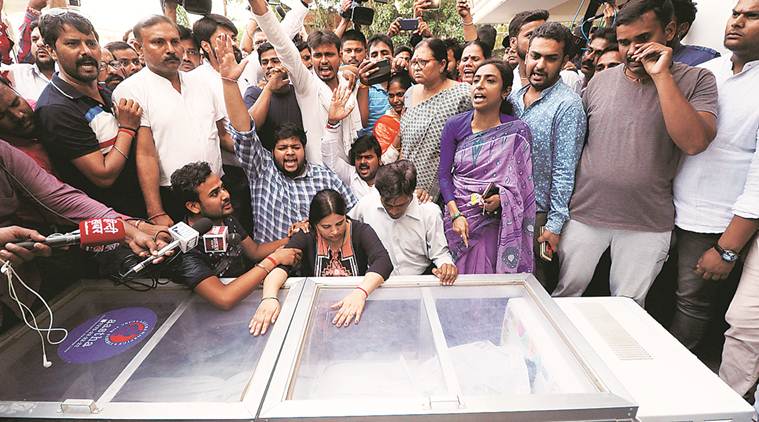Crime and complicity
Gomti Nagar murder may not be related to UP police’s ‘encounter culture’. But it calls for introspection.

Kalpana, wife of Apple executive Vivek Tiwari, weeps over his body at their home in Lucknow Saturday. (Express photo by Vishal Srivastav)
The police in India’s largest state are facing a serious crisis of credibility. In the last year and a half, the police in Uttar Pradesh have embarked upon a spree of exchanges of fire with alleged criminals that have left dozens dead and hundreds injured. In the wake of this shoot-first-ask-questions-later ethos, comes the dreadful incident in the Gomti Nagar area of Lucknow, where a senior executive with a tech company was shot dead in his private vehicle while traveling with a colleague from work. Many have linked this killing with the prevailing encounter culture of UP Police. The temptation to connect the dots is obvious. However, snap judgments often rely on a mistaken appreciation of the facts on the ground and end up offering unrealistic and inappropriate solutions.
Let’s begin by analysing the facts available in the public domain in the Gomti Nagar incident. The victim, Vivek Tewari, was driving his own car with a colleague. He was shot dead with a weapon fired by a police constable. This much is beyond doubt. What is doubtful is what happened in between. According to the eyewitness sitting next to the victim, the cops tried to stop the vehicle, her colleague didn’t stop, and the cops chased and shot him. According to the version of the cops, when they tried to stop the vehicle, the driver tried to run them over and they fired in self-defence.
Whichever version is found correct, from a legal standpoint, it will be difficult to prove it as a crime under Section 302 of IPC, that is, premeditated murder. It is a crime falling under Section 304, which covers culpable homicide not amounting to murder. It does not in any way take away from the horrifying and chilling circumstances of the incident but, unless there is something to link the victim with the accused prior to the incident, murder as defined by 302 will be difficult if not impossible to prove. This incident remains a shocking, callous and completely unprofessional use of a weapon by a policeman in uniform.
The rage and grief felt by the victim’s family and friends makes every right minded policeman hang their head in shame. And this being UP, the political blame game has started as well. However, private grief and public rhetoric aside, it certainly calls for serious introspection by the police leadership about our operating protocols and their implementation on the ground.
As a police officer, and as a citizen, I have often wondered about the efficacy of the naka system and random stop-and-search at night of vehicles across the country. I think the time is ripe for a comprehensive study of their costs and benefits. The practice has been with us since British times. Presumably, in those days, roads were few, traffic was minimal and blocking a few roads could ensure that escape routes were cut off. However, given the growing complexity of modern transportation networks, this appears to be an outdated practice with few tangible benefits.
In the metros and on our highways, nakas clog already congested roads. In other areas, they are points that create maximum complaints of extortion and misbehaviour against the police. The dilemmas facing the police are endless. On one hand, there is a constant public outcry over police harassment in the name of nakas and night checking, and yet the same public has passed laws that authorise policemen to search vehicles and arrest people for drinking inside, even if they are not driving.
So a certain amount of strife and friction between cop and citizen is hardwired into the basic processes of law enforcement. And while incidents like the Gomti Nagar shooting can be minimised by better procedures and tighter supervision, no police leader can honestly claim that they have a fool-proof method to guarantee that such tragedies would never happen on their watch.
Coming to the current encounter culture of UP police that is believed to have contributed to the Gomti Nagar shooting, the chain of reasoning is a bit far-fetched. On any given night, there are thousands of check points and random stops and searches taking place across the state. Awful as it was, the Gomti Nagar incident is an aberration in the overall scale of daily responsibilities of UP police. As for the current spate of encounters, again we need a sense of context and perspective.
In a state with a population of around 220 million, when we look at the number of police shootings in a year, we may want to also look at police fatalities, and then compare it with countries like the US, Brazil, Indonesia, countries that are closest in population size to UP. The numbers are pretty favourable. The US and Brazil have hundreds of deaths by shooting at the hands of the police each year. At the other extreme are countries like Germany and Japan where most years see zero killings by the police. It is a worthy ideal to aspire to, however the resources and systems that will lead to this situation are nowhere in sight.
Twelve years on, Prakash Singh is still running from pillar to post for the implementation of a SC judgement that offers fairly modest police reforms. So while our appetite for outrage is infinite, our capacity to digest reforms is minuscule. At the best of times, policing UP is a thankless and dangerous business. The culture of immunity is prevalent not merely in the police but far more so amongst criminals. They know that the prevailing ecosystem in UP — where politicians openly patronise criminals on caste lines and offer the more successful ones a fast track into electoral politics, the criminal justice system is overloaded with cases and unscrupulous elements in the legal profession can get you off the hook for anything, and policemen are willing to compromise for personal gain — is fertile ground for a lucrative career in crime. The encounter culture did not come out of nowhere. It is a flawed response to the multiple challenges of governance that plague India’s largest state.
The family of Vivek Tiwari deserves our sympathy and support. The UP police has taken exemplary departmental action against the accused constables and the government has stepped in with measures to support the family. However, the procedural lapses that led to this tragedy need to be addressed. More importantly, a more healthy criminal justice system, where trial and punishment are swift and certain, and the encounter culture is consigned to the dustbin of history, remains a distant dream.
The writer is serving as IG BSF Kashmir. Views are personal
For all the latest Opinion News, download Indian Express App
More From Abhinav Kumar
- Smoke and errorsPunjab government’s approach to drug menace is counter-productive. Compulsions of electoral politics and demagoguery continue to trump common sense, decency and evidence about what doesn’t…
- Kathua’s inconvenient truthsOutrage over heinous crime cannot be a replacement for strengthening rule of law. Civil society must start — and sustain — a debate on the…
- Rhetoric to reasoned debateThe SC order on Atrocities Act calls for a dispassionate discussion. At stake is not just the question of justice for victims of caste atrocities,…







































No hay comentarios:
Publicar un comentario